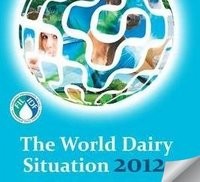
This report notes that 2011 was a very good year for the international dairy industry, with strong dairy markets and good weather conditions. While higher farm level prices stimulated a 2.5 percent (18.5 million metric tons) increase in milk production above 2010 levels, this was readily absorbed by the market. Cow milk production, representing 83 percent of total milk (the rest coming from buffalo, goats and sheep) increased in nearly every country monitored in the report, with notably large increases in the southern hemisphere.
This in turn led to increases in the volumes of dairy products produced, especially butter and skim milk powders. However, other products tracked in the report, including cheese, whole milk powder, liquid milks and fermented dairy products, also experienced higher production levels. Global per capita milk consumption increased by 1 kilogram to 107.3 kg (236.6 pounds).
Among the regions of the world, Asia accounts for 39 percent of world dairy production consumption, followed by Europe at 28 percent and North America at 13 percent. However, in other regions demand is growing faster; between 2005 and 2011, demand for dairy products grew by 26 percent in South America and by 22 percent in Africa.
World trade dairy products increased by 10 percent in 2011 to 58.2 million metric tons, well above the average annual growth rate during of 4 percent since 2000. World cheese trade increased 6.6 percent, with all the major dairy exporting countries seeing increased export volumes except for New Zealand. International trade in whole milk powder was also higher, up 7 percent, with most of the increased growth going to countries in Latin America and Africa.
The largest increase in world dairy product trade was 19 percent for skim milk powders and, while the primary destination remained South East Asia, other key markets like the Middle East, South America and Africa saw increased imports.
The full report includes many more details about world trends in milk production, processing, trade and consumption, as well as farm milk and wholesale dairy product prices. In addition, the report includes detailed reports on the state of the dairy industry in 53 individual countries.
The 235-page document features detailed research articles, including:
- Africa’s Growing Dairy Importance;
- An Analysis of Milk Production and Feeding Systems Worldwide;
- Measuring and Ranking Price Volatility: An Analysis and Comparison of Farm Gate Milk Prices in Selected Countries;
- Burgeoning Investments for Dried Dairy Products; and
- Water Footprint.





